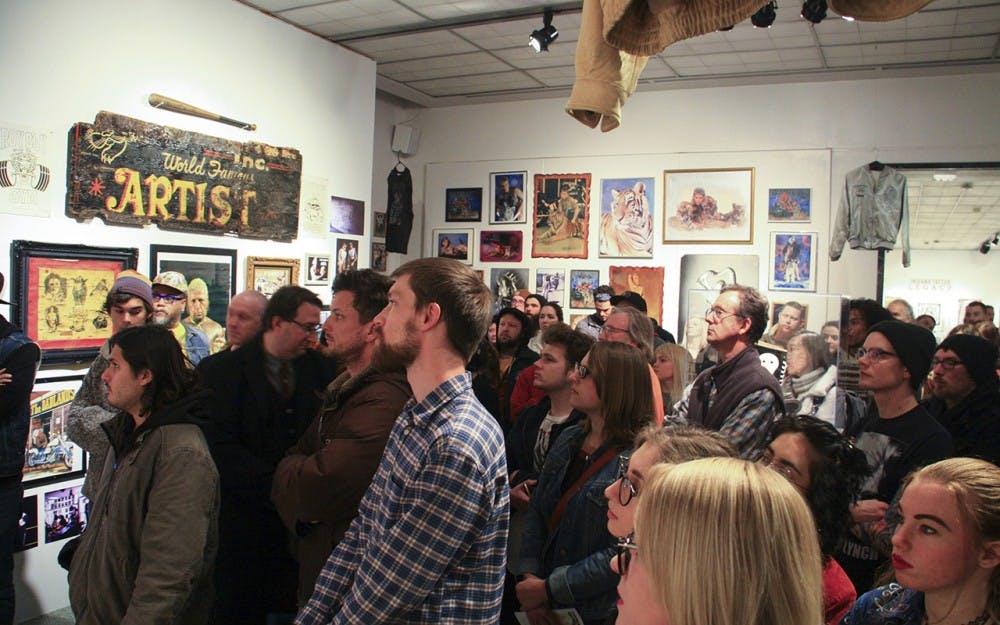Jereme Galloway of Time & Tide Tattoo worked on the right side of the gallery. The needle buzzed as his volunteer, a man in white shorts with many previous tattoos decorating his legs, lay on his side. Galloway began his work, surrounded by spectators and flash art pieces from Indiana tattooers.
After a series of lectures, Galloway and Jason Profant, another artist from Time & Tide Tattoo, occupied tables at opposite ends of the far right gallery and began live demonstrations as part of the opening of “Indiana Tattoo: History & Legacy” at the Grunwald Gallery of Art.
The opening Friday evening began with a talk by Eric Smolinski, an avid collector of memorabilia related to Roy Craig Cooper, also known as Roy Boy, a prolific Indiana tattoo artist who practiced during a time when tattooing was an illegal act.
“Roy would be really happy being able to see everyone in this room that really truly wants to see what’s going on in Indiana tattooing,” he said. “This exhibit is crazy. You get the old, you get the new, you get the psychotic.”
Smolinksi highlighted that Roy Boy was many things in his life, including a pilot, owner of a gym, exotic animal trainer and much more. He even produced 10 films in his lifetime. One of the movies Roy Boy produced played as an introduction to Smolinski’s talk, during which he showed off his vast collection of signs, photographs and other artifacts that represented parts of Roy Boy’s life and legacy in Gary, Indiana.
Images in the center gallery included photos of Debbie Cooper, Roy Boy’s third wife. In the photos she models the tattoos that covered much of her body alongside some of the tigers Roy Boy was infamous for keeping around his shops.
The artifact part of this exhibit included a baseball bat, hung above the sign for the tattoo shop. During Smolinski’s talk, curator Jeremy Sweet asked about it.
“He would beat people up with it, it was pretty much a ‘Get out of my place if I don’t like the way you’re doing things,’” Smolinski said. “I don’t even know if he would be the one that would beat you up with it, or if he would train his guys to beat you up with it.”
Though there was a content warning at the door, it was not uncommon to see families with young children among the hundreds of people gazing at the images of tattoos, both on paper and on bodies, at the exhibit. Many of the listeners had tattoos of their own, ranging from full sleeves of vibrant hues to minimalist ink.
The next speakers in the lineup were co-curators Sweet, associate director of the Grunwald Gallery, and Colin McClain, a tattoo artist from Time & Tide Tattoo.
Sweet said he and McClain have worked on such exhibitions on a smaller scale since 2011 with the goal of showing tattoo art’s variety.
“We kind of built the relationship into some pop-up exhibits where we’d show tattoo art, flash, paintings next to sculpture, digital art, putting it all in the same playing field for the consumer to digest and appreciate,” Sweet said.
Sweet said the acquisition of a hand-decorated jacket, one of the pieces on display in the historical part of the exhibit, is what really set the show into motion, though both curators agreed that the beginning of what became a massive retrospective tattoo exhibit is difficult to trace.
“It’s hard to remember how it all took off,” McClain said. “At some point it changed from just a contemporary show to ‘Hey, maybe we should highlight some of the historical aspects of Indiana tattooing.’”
The next step was contacting Smolinski to learn more about Roy Boy, Sweet said.
From there the exhibit grew into what it is now — a three-part show featuring a look at tattoos of the past in one space, with images from the Kinsey Institute and beyond, the middle gallery full of Smolinski’s collectibles and then a contemporary gallery with flash pieces by more than 30 Indiana tattooers.
By the time the exhibition was complete Sweet said the two had connected some historical dots and, though much of what they found was unsubstantiated with proof, the process was informative.
“I wish that we had another year, I wish that we could keep digging, keep finding more, and we can,” McClain said. “It’s not something that we necessarily need to stop doing, and I do think it’s our responsibility to connect those dots and find out what the narrative is and preserve the history of our craft.”






